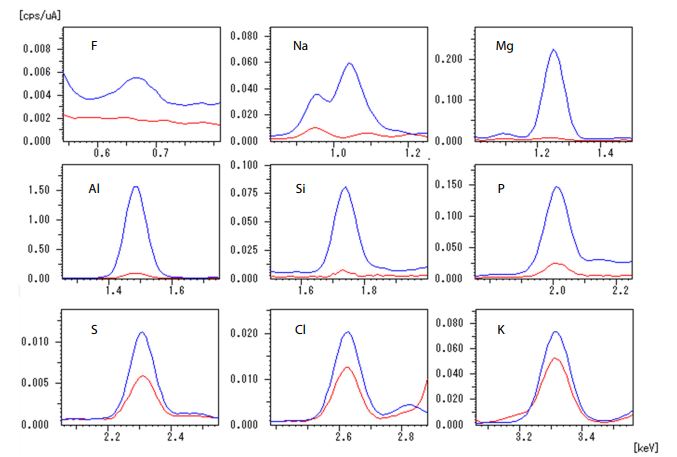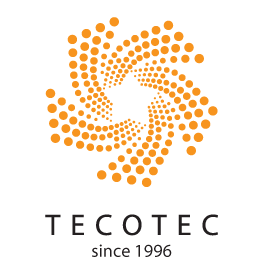News
X-Ray Fluorescence Analysis of Light Elements in Liquid Samples – EDX-8100 and Helium Purge Unit
Shimadzu’s EDX-8100 is an energy dispersive X-ray fluorescence spectrometer with high sensitivity for light elements and can be configured with an optional helium purge unit. The helium purge unit enables high-sensitivity analysis of light elements in samples that cannot be depressurized to a vacuum state such as solutions and samples that generate gas. As one effect, detection of fluorine (F) in liquid samples is possible with the EDX-8100. The detection limits of the elements F to K in liquid samples in a He atmosphere and differences depending on the film used to hold the samples were evaluated.
- Elements and Samples
The samples are shown in Table 1. Pure water was used to calculate the background intensity.
Table 1 Elements, Contents, and Solutions
| Element | Content [ppm] | Solution |
| Fa | 94,962 | Preparation |
| Ma | 20,000 | Preparation |
| Mg | 20,000 | Preparation |
| Al | 20,000 | Preparation |
| Si, P, S, Cl, K | 1,000 | Atomic Absorption Standard Solution |
| None | - | Pure Water |
- Sample Pretreatment
Approximately 5 mL of each sample was introduced directly into a film-covered sample container. The three films shown in Table 2 were used.
Table 2 Sample Holder Films
| Name | Thickness (µm) | Compositional Formula |
| Prolene® (Chemplex) | 4 | C3H6 |
| Polypropylene | 5 | C3H6 |
| PET | 6 | C10H8O4 |
- Detection Limits
(1) Atmosphere: Air/He
Fig. 1 shows the measured spectra in air and a He atmosphere when using the polypropylene film. Table 3 shows the detection limits calculated from the intensity and measurement conditions (current and integration time). The He atmosphere enabled detection of F and Na, and improved detection of Mg by 40 times, Al and Si by 8 times, and P and S by approximately 2 times.

Fig. 1: X-Ray Fluorescence Spectra for F to K [Blue: He Atmosphere, Red: Air]
Table 3: Detection Limits (1) Differences Depending on Atmosphere [ppm]
| Atmosphere | 9F | 11Na | 12Mg | 13Al | 14Si | 15P | 16S | 17Cl | 19K |
| Air | - | - | 3,300 | 210 | 91 | 25 | 16 | 2323 | 6.3 |
| He | 41,000 | 680 | 84 | 26 | 11 | 11 | 7.8 | 15 | 5.1 |
(2) Differences Depending on Film
Three types of films were used in measurements in a He atmosphere. Fig. 2 (next page) shows the spectra, and Table 4 shows the detection limits. Prolene (Chemplex Inc.) with a thickness of 4 μm displayed the highest sensitivity, and the influence of the film thickness and composition on absorption increased with lighter elements.

Fig. 2: X-Ray Fluorescence Spectra for F, Al, and K [Blue: Prolene (Chemplex), Red: Polypropylene, Green: PET]
Table 4: Detection Limits (2) Differences Depending on Film [ppm]
| Film | 9F | 11Na | 12Mg | 13Al | 14Si | 15P | 16S | 17Cl | 19K |
| Prolene® | 18,000 | 480 | 73 | 22 | 10 | 9.7 | 7.5 | 14 | 4.7 |
| Polypropylene | 41,000 | 680 | 84 | 26 | 11 | 11 | 7.9 | 15 | 5.1 |
| PET | - | 5,400 | 340 | 55 | 54 | 25 | 24 | 18 | 5.8 |
- Conclusion
Measurements of liquid samples by EDX are possible regardless of conditions such as concentration, organic or inorganic material, suspension, and viscosity. This technique is not limited to solutions, but is also effective with samples such as the following, which are difficult or impossible to depressurize to a vacuum.
- Teeth and other biomaterials (fracture, alteration)
- Porous materials such as zeolite (time required to reach measurement vacuum)
- Fibers and clothing (porous, wet)
- Ultrafine particles such as graphite powder (scattering)
- Sealed and enclosed materials (bursting)
This technique is effective for quickly determining the presence and content of light elements in the abovementioned materials.
Source: ETA
Others
- TECOTEC GROUP ATTENDED SHIMADZU’S SERVICE MANAGER MEETING IN 2022
- TECOTEC HANDED OVER EDX-7000 X-RAY FLOURESCENCE SPECTROMETER AT NIDEC CHAUN CHOUNG VIETNAM
- INSTALLATION OF CHIP PROCESSING SYSTEM – LANNER/ GERMANY
- TECOTEC completed installation of EDX-LE Energy dispersive X-ray Fluorescence spectrometer at DYT Vina
- TECOTEC DELIVERED AND INSTALLED THE 2ND X-RAY FLUORESCENCE SPECTROMETER - EDX-LE PLUS AT TABUCHI
- TECOTEC Group has handed over PDA-7000 Optical Emissions Spectrometers for Nihon Plast Vietnam
- Bowman XRF Coating Measurement System For Electroless Nickel Plating
- TECOTEC DELIVERED AND INSTALLED SMX-2000 SYSTEM TO NIDEC TECHNO MOTOR VIETNAM



